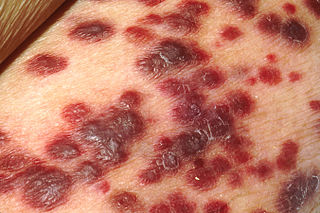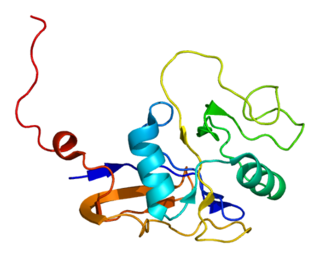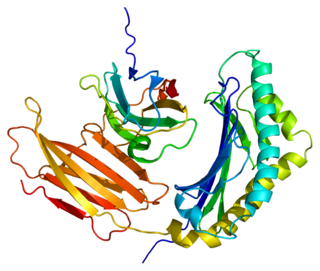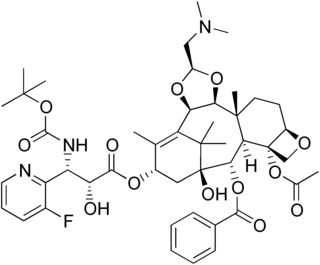Related Research Articles

Kaposi's sarcoma-associated herpesvirus (KSHV) is the ninth known human herpesvirus; its formal name according to the International Committee on Taxonomy of Viruses (ICTV) is Human gammaherpesvirus 8, or HHV-8 in short. Like other herpesviruses, its informal names are used interchangeably with its formal ICTV name. This virus causes Kaposi's sarcoma, a cancer commonly occurring in AIDS patients, as well as primary effusion lymphoma, HHV-8-associated multicentric Castleman's disease and KSHV inflammatory cytokine syndrome. It is one of seven currently known human cancer viruses, or oncoviruses. Even after so many years of discovery of KSHV/HHV8, there is no known cure for KSHV associated tumorigenesis.

Carcinoembryonic antigen (CEA) describes a set of highly related glycoproteins involved in cell adhesion. CEA is normally produced in gastrointestinal tissue during fetal development, but the production stops before birth. Consequently, CEA is usually present at very low levels in the blood of healthy adults. However, the serum levels are raised in some types of cancer, which means that it can be used as a tumor marker in clinical tests. Serum levels can also be elevated in heavy smokers.

The selectins are a family of cell adhesion molecules. All selectins are single-chain transmembrane glycoproteins that share similar properties to C-type lectins due to a related amino terminus and calcium-dependent binding. Selectins bind to sugar moieties and so are considered to be a type of lectin, cell adhesion proteins that bind sugar polymers.

The CD44 antigen is a cell-surface glycoprotein involved in cell–cell interactions, cell adhesion and migration. In humans, the CD44 antigen is encoded by the CD44 gene on Chromosome 11. CD44 has been referred to as HCAM, Pgp-1, Hermes antigen, lymphocyte homing receptor, ECM-III, and HUTCH-1.

ATP-binding cassette sub-family B member 5 also known as P-glycoprotein ABCB5 is a plasma membrane-spanning protein that in humans is encoded by the ABCB5 gene. ABCB5 is an ABC transporter and P-glycoprotein family member principally expressed in physiological skin and human malignant melanoma.
Minretumomab (CC49) is a mouse monoclonal antibody that was designed for the treatment of cancers that express the TAG-72 antigen. This includes breast, colon, lung, and pancreatic cancers. Apparently, it never got past Phase I clinical trials for this purpose.

Tumor antigen is an antigenic substance produced in tumor cells, i.e., it triggers an immune response in the host. Tumor antigens are useful tumor markers in identifying tumor cells with diagnostic tests and are potential candidates for use in cancer therapy. The field of cancer immunology studies such topics.

Mucin 1, cell surface associated (MUC1), also called polymorphic epithelial mucin (PEM) or epithelial membrane antigen or EMA, is a mucin encoded by the MUC1 gene in humans. MUC1 is a glycoprotein with extensive O-linked glycosylation of its extracellular domain. Mucins line the apical surface of epithelial cells in the lungs, stomach, intestines, eyes and several other organs. Mucins protect the body from infection by pathogen binding to oligosaccharides in the extracellular domain, preventing the pathogen from reaching the cell surface. Overexpression of MUC1 is often associated with colon, breast, ovarian, lung and pancreatic cancers. Joyce Taylor-Papadimitriou identified and characterised the antigen during her work with breast and ovarian tumors.

Mucin 4 is a mucin protein that in humans is encoded by the MUC4 gene. Like other mucins, MUC-4 is a high-molecular weight glycoprotein.

Lysosome-associated membrane protein 2 (LAMP2) also known as CD107b, is a human gene. Its protein, LAMP2, is one of the lysosome-associated membrane glycoproteins.

Melanotransferrin is a protein that in humans is encoded by the MFI2 gene. MFI2 has also recently been designated CD228.

Carcinoembryonic antigen-related cell adhesion molecule 1 (CEACAM1) also known as CD66a, is a human glycoprotein, and a member of the carcinoembryonic antigen (CEA) gene family.

Lysosomal-associated membrane protein 1 (LAMP-1) also known as lysosome-associated membrane glycoprotein 1 and CD107a, is a protein that in humans is encoded by the LAMP1 gene. The human LAMP1 gene is located on the long arm (q) of chromosome 13 at region 3, band 4 (13q34).

Galectin-3-binding protein is a protein that in humans is encoded by the LGALS3BP gene.

Prolactin-inducible protein also known as gross cystic disease fluid protein 15 (GCDFP-15), extra-parotid glycoprotein (EP-GP), gp17seminal actin-binding protein (SABP) or BRST2 is a protein that in humans is encoded by the PIP gene. It is upregulated by prolactin and androgens and downregulated by estrogen.

Trophoblast glycoprotein, also known as TPBG, 5T4, Wnt-Activated Inhibitory Factor 1 or WAIF1, is a human protein encoded by a TPBG gene. TPBG is an antagonist of Wnt/β-catenin signalling pathway.
Tumor-associated glycoprotein 72 (TAG-72) is a glycoprotein found on the surface of many cancer cells, including ovary, breast, colon, lung, and pancreatic cancers. It is a mucin-like molecule with a molar mass of over 1000 kDa.

Tesetaxel is an orally administered taxane being investigated as a chemotherapy agent for various types of cancer, including breast cancer, gastric cancer, colorectal cancer, and other solid tumors. It differs from other members of the taxane class in that it is administered orally, not intravenously.

Carlos Cordon-Cardo is a Spanish-born American physician and scientist known for his research in experimental pathology and molecular oncology. He holds the "Irene Heinz Given and John LaPorte Given" Chair in Pathology at Mount Sinai School of Medicine.
Piet Borst is emeritus professor of Clinical Biochemistry and Molecular Biology at the University of Amsterdam (UVA), and the former Director of Research and Chairman of the Board of Directors of the Netherlands Cancer Institute and the Antoni van Leeuwenhoekziekenhuis (NKI-AVL), where he still works as staff member.
References
| This oncology article is a stub. You can help Wikipedia by expanding it. |